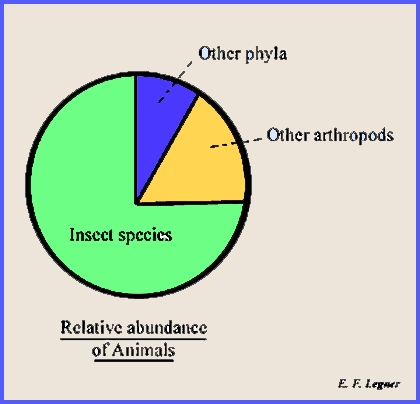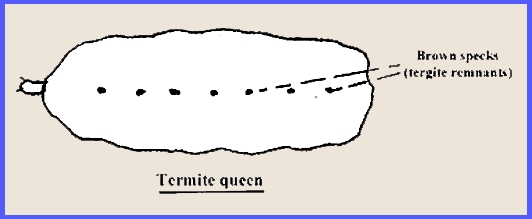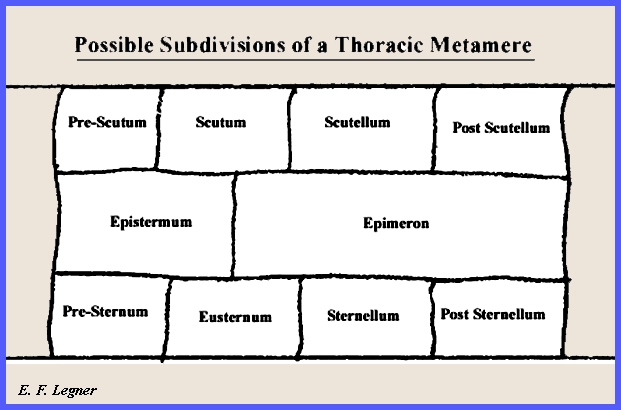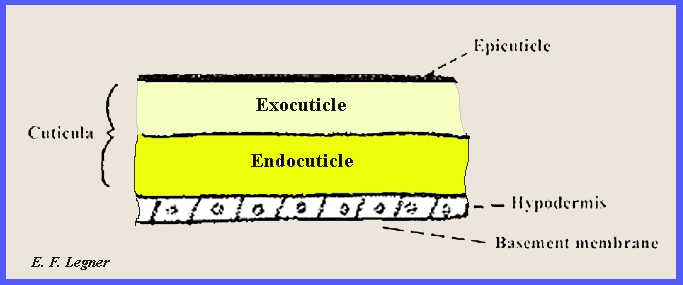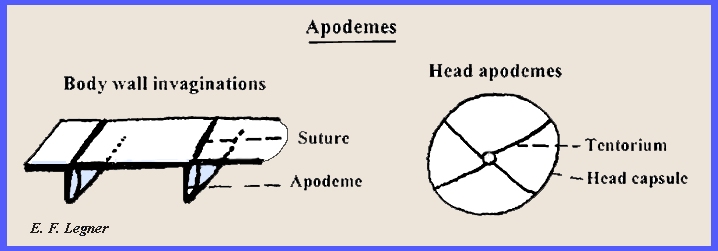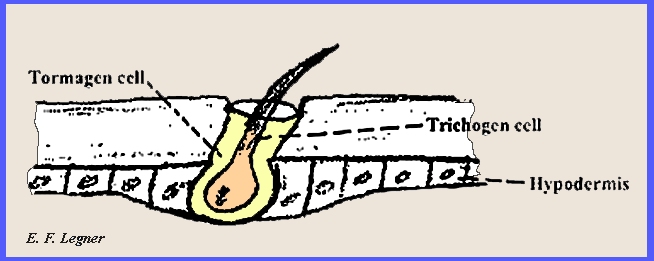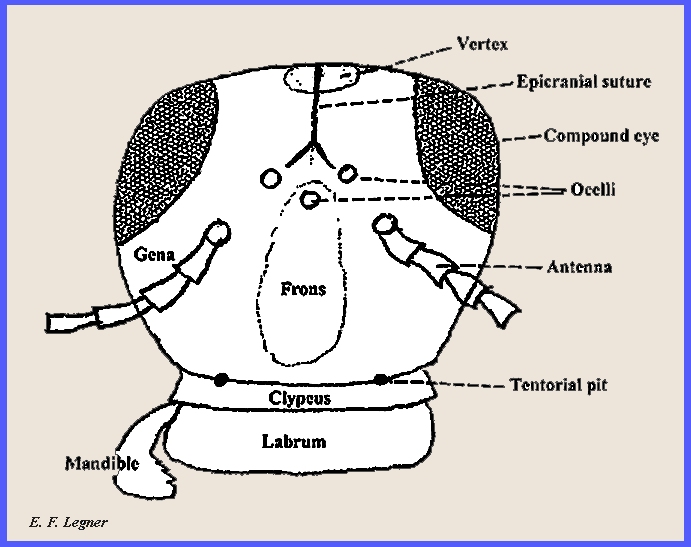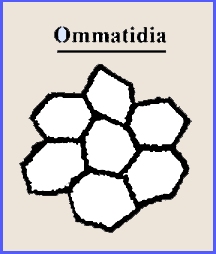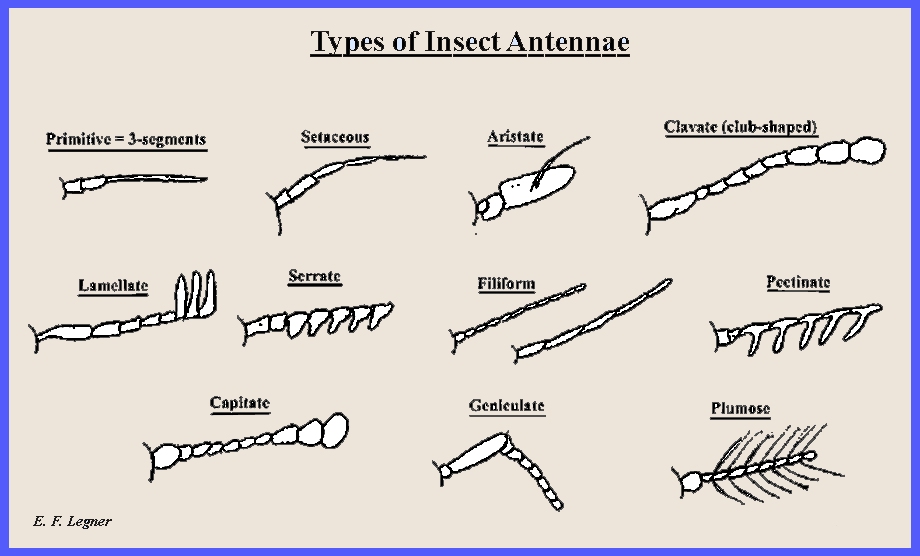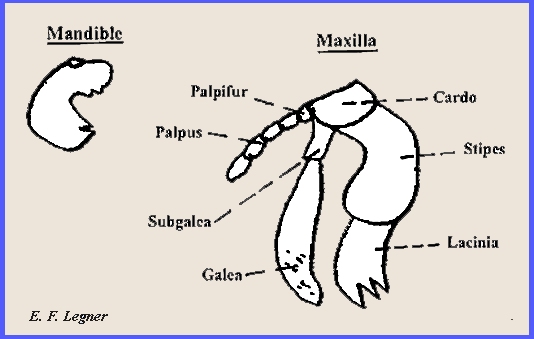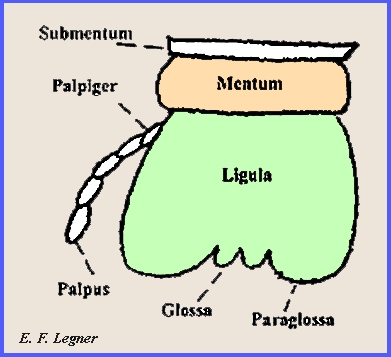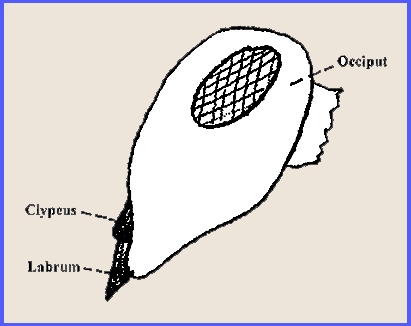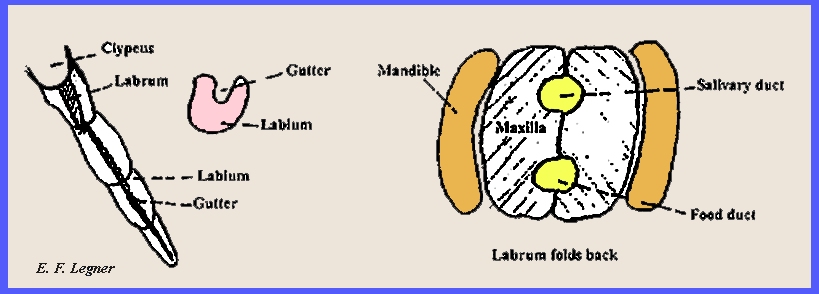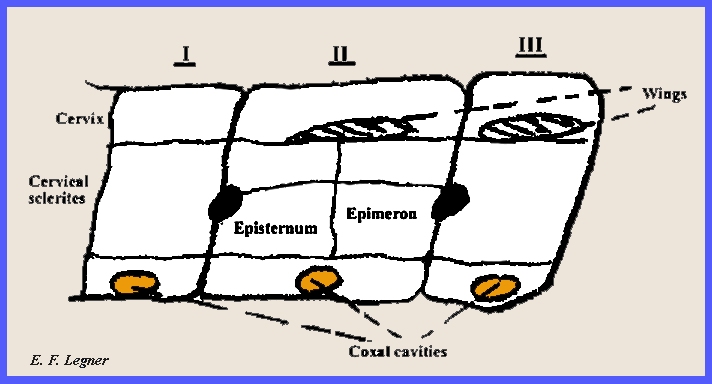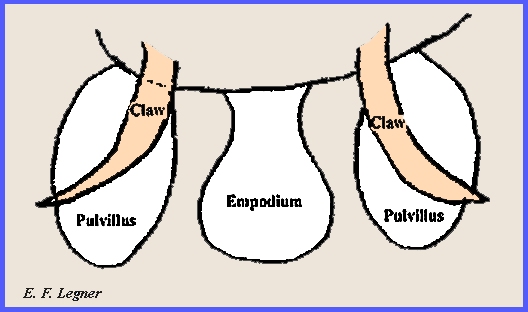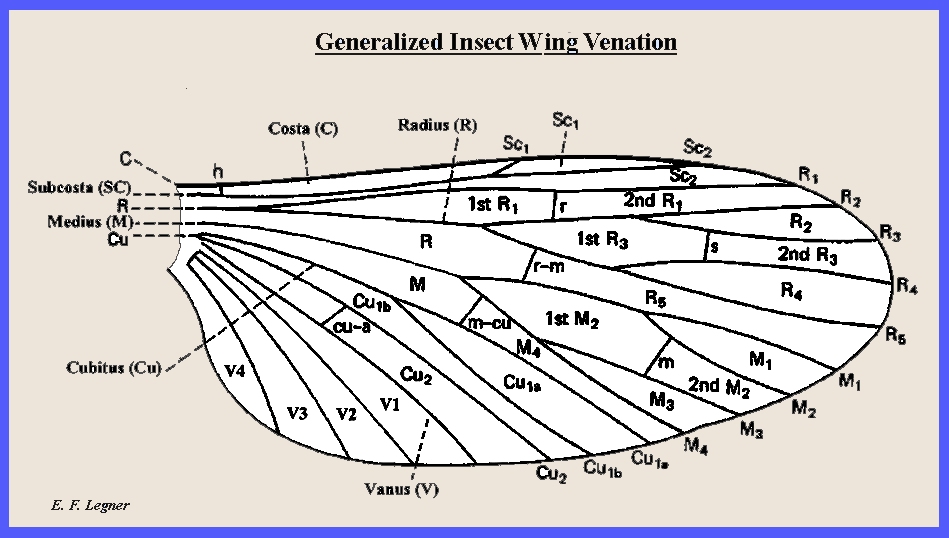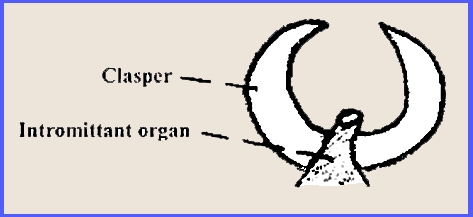File:
<entomology.htm> Indexes: < (Entomology), (Invertebrates), (General Index)> <Invertebrate Bibliography> <Glossary> <Site Description> < Home>
|
Entomology--The Study of
Insects 1 Kingdom: Animalia, Phylum: Arthropoda Subphylum: Hexapoda: Class: Insecta: Entomology Introduction & External Morphology (Contact) |
Please CLICK on underlined
categories to view and on included
illustrations to enlarge:
Depress Ctrl/F to search for
subject matter:
|
General
Characteristics of Insects Superfamilies, Families & Subfamilies |
Behavior, Ontogeny,
Reproduction |
|
|
The
present arrangement of insect orders is based on ever increasing complexity
and presumed evolution of the most primitive [Thysanura] to the more advanced
[Hymenoptera] (View All Orders.) Previous and synonymous names of groups
are included in parentheses. The Entognatha (Collembola) are
included herein as a primitive insect precursor group. Emphasis has been placed on
morphological and behavioral characteristics that are easily discernable, and
a simple diagrammatic style suitable for lecturing is used for most of the
illustrations. Insect families that
are generally more abundant or which have the greatest economic or public
health importance are treated in greatest detail. A hand lens and a binocular microscope with 20X magnification are advisable for those
wishing to view living and preserved specimens. Greater detail on a particular group or species may be found by
referring to publications listed in the References or through Internet
searches. This is a self-contained database with a minimum of
links outside its limits. Independent
Internet searches are encouraged for greater detail on a particular insect
group. All information contained
herein is for general public use according to the rules set by the Creative
Common Deed. General Characteristics of Insects The term "Entomology" is derived from the
Greek "Entoma" meaning "cutting-into." Entomology then refers to the fact that
insects have a resting stage and there is segmentation of the body. Therefore, a complete translation might
be, "Study of the individual divided into sections that forms in
cysts." Entomological
instruction also has traditionally included the study and control of
phytophagous mites, which cause extensive damage to food plants (See Arachnida). With regard to the position of Insecta in the Animal
Kingdom, it is estimated that there are at least 1,400,000 animal species in
the Kingdom. This may be broken down
into Chordata = ca. 41,000; Mollusca = ca. 81,000; Protozoa = ca. 32,000 and
Arthropoda other than Insecta = ca. 73,500.
The Arthropoda including Insecta have over 900,500 species. In North America there have been over
100,000 described insect species.
Most specialists will agree that many more exist that have not been
described or discovered. In addition
there are many strains or races found withing a single insect species. Recent DNA evidence from humans reveals
the complexities involved in race formation, but because of the many more
individuals within an insect species race formation can result in the
formation of exponentially many more over a short period of time. Taxonomic
separation is so difficult for some groups that only laboratory tests of compatibility
can determine with certainty if there is reproductive isolation. The Muscidifurax genus of parasitic
Hymenoptera is a prime example. A
graphic representation of the known relative abundance as of 2010 may be
viewed in <Ent1>. History of Entomology. -- The Bible mentions locusts and flies, and
there are references to insects by the early Egyptians and in Chinese
writings. Aristotle in 350 BC. made
an attempt to classify insects. In 1758 Linnaeus began the system of binomial
nomenclature and described seven orders of insects. Between 1795 and 1819 Peck, a professor of Biology at Harvard
University, stimulated the development of Economic Entomology. In 1841 Harris, a student of Peck's,
produced the first book on Economic Entomology. This was the first case of Tax Funds expended for such a work. The year 1854 marks the birth of Entomology as a
profession. Townend Glover, of the U.
S. Department of Agriculture and Asa Fitch an employee of the State of New
York were hired as entomologists. From 1867 to 1890 there was a rapid growth of
Entomology in the United States. In
1807 Michigan State College offered the first course in Entomology and in
1888 Michigan established the first Agricultural Experiment Station. By 1950 there were over 4,600 professional
entomologists in the United States alone. In the latter 1800's C. V. Riley, Chief Entomologist of
the U. S. Dept. of Agriculture obtained the Rodolia cardinalis predator from
Australia to combat the invaded cottony-cushion scale in California. Then L. O. Howard organized the Bureau of
Entomology in the U. S. Dept. of Agriculture. J. H. Comstock, professor at Cornell University, followed these
by writing textbooks on Entomology. The year 1942
marked the beginning of synthetic insecticide development which has persisted
into the 21st Century. Fossil Records. -- The first records of insect-like
invertebrates are found in the rocks of the Devonion period. These take the
form of fragmentary remains of invertebrates similar to the Entognatha, and there is little
doubt that wingless insects of this kind were abundant in that period when
there was a great abundance of vegetation of pterydophytes and other plants
under very wet conditions. It is probable that thysanuran insects similar our
contemporary silver fish, Lepisma, lived
then.
Insect Numbers. -- Periodic outbreaks of
insects occur. Some familiar ones are
grasshopper swarms, migrating butterflies, wireworm invasions, mayfly swarms,
forest tent caterpillar invasions, lake fly swarms and Mormon cricket invasions.
The abundance of very tiny parasitic species, for example, is almost
impossible to determine. The honeybee is an example of extraordinary
numbers. In summer a healthy honeybee
colony contains about 55,000 individuals and produces about 200,000
individuals per year. The persistence of insects in the environments may be
realized when considering that no single species has ever been deliberately
eradicated. Insect Distribution. -- Insects are found almost
everywhere except in the sea where they may occur in rare exceptions. Insects also parasitize most other animals
(e.g., even sea lions have lice). Useful Attributes of Insects. --
Insects do twice as much good as harm.
They pollinate plants, serve as natural predators and parasites of
noxious insects, are scavengers and produce useful products such as honey,
wax, silk and shellac. Their great
fecundity and rapid development continue to make them valuable for studies in
animal behavior and genetics. Insects also are valuable scavengers and soil insects
improve soil texture. Many insects
destroy weeds. They are important food
sources for fish, birds and mammals and in some parts of the world for
humans. The aesthetic value of insects for collections, designs
and in zoological parks cannot be ignored. Harmful Aspects of
Insects. -- There are more than 11,000 pest species of insects in the
world. They can cause over 12 percent
loss to agronomic crops and they are capable of infesting almost every crop
grown. Their high reproductive
potential makes them especially important as pests. Such groups as mosquitoes, tsetse flies, wasps, etc., not only
cause great annoyance but some are able to transmit serious pathogens to
humans and other animals or they may kill directly. Some species have figured prominently as carriers of typhoid,
dysentary and malaria. Economic Significance. -- The Petrochemical
Industry has figured actively in the control of pest insects. It costs about 1.8 million U.S. dollars to
marked an insecticide. Entomology is
also a fascinating science due to the diversity of forms, habitats, response
to stimuli, endurance, etc. There
continues to be a great demand for entomologists in the control of insect
pests. |
Orders of Insects (Also see entorder.htm)
Future taxonomic changes will require agreement among specialists.
|
Subphylum:
Hexapoda Class: Entognatha -- Diplura, Protura, Collembola Class: Insecta – Insects ----------------------
Thysanura -- Bristletails
Ephemeroptera -- Mayflies
Odonata -- Dragonflies, Damselflies Orthoptera -- Locusts, Grasshoppers, Crickets,
Cockroaches, Walking sticks, Mantids Dermaptera -- Earwigs Isoptera -- Termites, White ants Embioptera -- Webspinners Plecoptera -- Stone flies Zoraptera -- Zorapterans Psocoptera -- Psocids Mallophaga -- Chewing lice |
Phthiraptera (= Anoplura)-- Sucking lice
Thysanoptera -- Thrips Hemiptera -- Plant bugs, Stink bugs, Chinch bugs, Ambush bugs, Water striders, Toad bugs Homoptera -- Cicadas, Psyllids, Aphids, Scales Neuroptera -- Alderflies, Snakeflies, Lacewings, Antlions Coleoptera -- Beetles Strepsiptera -- Twisted-winged parasites Mecoptera -- Scorpion flies Trichoptera -- Caddis flies Lepidoptera -- Butterflies, Moths Diptera -- Flies Siphonaptera -- Fleas Hymenoptera -- Bees, Wasps, Ants |
|
External Morphology of Insects [For greater detail see <Morphology>] The insect's body is composed of metameres. This is a series of metameres that
together comprises the exoskeleton. Exoskeleton
Function. -- The exoskeleton gives
the body form and shape. It contains the
body fluids and affords protection from desiccation and predators. It consists of chitin arranged in plates
called sclerites joined by a membrane. Body Regions. -- Every region of the
insect has been designated for specific functions. The head is a composite of five metameres and serves for
sensory reception and food ingestion.
The thorax is a composite of three metameres and serves for
locomotion. The abdomen is a
composite of ten or more metameres. Function
of The Body Regions. -- The head is sensory and serves for the ingestion of
food. The thorax contains structural
parts that are used for locomotion.
The abdomen houses the visceral structures. A large portion is involved in respiration, and all of the
excretion and reproduction activities are confined there. Division of a Metamere. -- The following diagram
<ent2> shows the various divisions: The various plates are called sclerites. Between the sclerites there exit
membranous invaginations, which permit articulation of one plate on
another. The exoskeleton stretches
like cellophane, which retains its stretched shape (unlike rubber). The termite queen has on her body brown specks that are
the remnants of dorsal sclerites (= tergites). Her abdomen will never resume its original
smaller size. Metameres telescope one upon the other: The legs attach
to the body by membranes: A suture is any point on an insect's
body where there is an invagination. Subdivisions of Thoracic
Metamere.--
The following diagram shows the possible subdivisions of a thoracic metamere. ----------------------------------------------------- Gross Morphology. -- The hypodermis
secretes the exoskeleton. The epicuticle is a waxy, water repellent substance. The exocuticle is
hard and heavily pigmented. The endocuticle is soft and not as deeply pigmented. Chemical Composition. -- Chitin
is a soft, pliable and not pigmented nitrogenous polysaccharide. Polymerized proteins may become
impregnated into the chitin making it
hard (= sclerotin).
Various degrees of sclerotization exist. KOH dissolves out the pigments and is useful in clearing
specimens in preparation for laboratory examination. Apodemes. -- These are
invaginations of the body wall. They
serve to brace various parts of the body.
They are called a tentorium in the head. Sense Perception. -- The integument also
is sensitive to touch (tactile), chemical (smell) and sound (hearing). Outgrowths of The Body Wall. -- Outgrowths without any
modifications beneath are spines. Setae. -- Setae have a sensory cell
associated with them called a trichogen. Poison glands may occur where the seta is hollow and
associated with glands. Urticating hairs of poisoneous caterpillars are
examples. Setae are also
used as a method of classification:
their pattern is constant per species. Johnston's Organ located on the second antennal
segment may function in sound perception. The position of the head is variable and may be
projected forward (hypognathous), downward (prognathous) or backward (opistognathous). Compound Eyes. -- These vary in size in
different insects. They consist of ommatidia, which are hexagonal pieces placed
together. The numbers of ommatidia in
a compound eye varies and may vary from several hundred to 28,000 in a
dragonfly. The insect's vision is a
mosaic pattern, which is very efficient for detecting motion. Ocelli. -- There are usually three ocelli but some
species may have only one, each of which consists of a single lens. Ocelli detect motion and changes in light
intensity. Other
Regions. --
Various other portions of the head are the Vertex, Gena, Tentorial Pits and Frons (see diagram <Ent11>). Antennae. -- There is one pair of
antennae, and the various types that are found in insects may be viewed in
the following diagram (Ent13): The mandibles, maxillae and labrum may be remnants of
appendages. There is also a clypeus,
labium and hypopharynx. These are discussed
as follows: The mouthparts are
important in insect classification. The Labrum holds food in the mouth. Mandibles
are
tooth-like structures that articulate with the head, and there are two of
them. Large muscles are attached to
them and they hare modified to perform many tasks. They are also segmented but this is usually not obvious. Maxillae consist of several parts
as shown in Figure Ent14. They push food into the mouth. The Hypopharynx
is a
single bulbous tongue-like salivary gland that is attached to the roof of the
mouth. It is highly sensory. The Labium is believed to be a fusion
of two primitive structures (Fig. Ent16). It consists of palpi, which function as a
food pushing structure and also holds food in the mouth. Occiput. -- This is the side of
the head as shown in Figure Ent15: The Chewing
type is the basic primitive
kind found in the grasshopper. The Cutting-sponging type is
found in the horsefly and deerfly.
The mandibles are long and lance-like for cutting or stabbing. The maxillae are long and slender and help
the mandibles. The labium is
sponge-like, while the hypopharyns and epipharynx are a sucking tube. The Sponging
type is found in the
housefly. The mandibles and maxillae
have disappeared. The fly sponges up
with the labium and sucks up with a tube. The Chewing-lapping type is
found in the honeybee. The mandibles
and labrum are like that in the Chewing type, but the bee uses them for wax
molding. The maxillae and labium have
combined to form a tube-like structure for lapping and sucking. Sucking
Mouthparts -- These are specially
modified mouthparts found in Diptera, Hymenoptera and Homoptera. They are homologized with chewing
mouthparts and are located underneath the clypeus (Fig.
Ent17) Piercing-sucking mouthparts are found in the
mosquito, leafhoppers and fleas. The
hypopharynx and epipharynx are extended into stylets of which there are four
or six. The labium forms a protective
sheath around the stylets. Stylets
form two tubes. Saliva goes down one
tube and food up the other. Siphoning mouthparts
are
found in butterflies and moths. The
maxillae are the only part remaining and have fused into a long tube. Only liquids are fed upon. ------------------------------------------- The thorax is composed of three
metameres: (1) Prothorax,
(2) Mesothorax and (3) Metathorax. The pleural regions of these are
associated with well-developed legs and wings. There are usually no spiracles on the prothorax, and wings may
occur only on the meso and metathorax.
A pronotum is formed as an extension of the
prothorax, which gives strength. A sulcus or invaginated line is present that aids in wing
movement. Coxal sclerites are located
in a membrane around the coxa that assists in moving the leg. The spiracles are
complex structures, the opening and closing of which may be controlled by the
insect. The Insect Leg. -- There are five parts
to the insect leg: the coxa,
trochanter, femur, tibia, and tarsus.
The tibia may bear sharp, fixed spines. There may also be a movable spine or spur located at the distal
end, which can articulate. On the
distal of the tarsus there is a pair of claws. There is also a median pad-like structure
called the empodium and lateral pad-like structures
called pulvillae. The Insect Wings. -- Insects are the only
invertebrates with wings and wings are important in insect
classification. They are added to the
body and not derived from modified appendages as in the bird or bat. They are possibly expansions of the body
wall that were originally used as gliding structures. The pleural regions are formed out of the
necessity for lateral bracing.
Movements of the body wall caused by muscle contraction move the
wing. Longitudinal muscles are
strongest on the down stroke. The
insect must also tilt its wings and they rotate on the pleural sulcus. In many insects the wings are formed as pads externally
(e.g., grasshopper). In other insects
they are internally formed (e.g., caterpillar). Branches of the tracheal trunks lead into the pads. In the latter stages of development a sac
collapses, cells slough away leaving two sheets of cuticula. The veins are more concentrated and more
heavily sclerotized at the leading edge of the wing. Wing Morphology. -- There is much
variation in forms. Wings developed
late in insect evolution. Pleural
sclerites are not developed in primitive forms (e.g., Thysanura). In some highly evolved parasitic orders
the wings are wanting. Structures in
the thorax reveal that they were primitively winged (e.g., fleas) as pleural
sclerites are present. There are usually two pairs of wings, but Diptera have
one pair with remnants of a second pair, called halteres. There appears to be a trend toward the
development of one metamere, the mesothorax, for flight. Wings are borne only on the meso and
metathorax but never on the prothorax. Some insects, like beetles, have their forewings
modified as covers. Many wings have
scales or hairs. Scales are arranged
as shingles on a roof. A scale is a
modified seta as is also a hair. The generalized insect wing and its venation may be
viewed at Ent20. Venation varies with different
forms. In the long and narrow wing
the vanal veins are absent. In the
wide wing the great width is due to expansion of the vanal region. Sometimes many
veins will coalesce together and many will completely disappear. Coalescences may be determined by close
examination. Where R-4 and R-5 have
come together the code given is R4+5. Crossveins are designted by lower
case letters as follows: humeral (h),
radial (r), sectorial (s), radial-medial (r-m), medial-cubital (m-cu). Cells in the
wings may be either closed or open. There may be
some modified structures on the wings.
Wing Uniting Mechanisms are often
present. A stiff spine at the base of
the hind wing is called a frenulum. In moths a single spine is characteristic
of the male and a cluster of spines of the female. Hamuli are found in bees. [See Ent21] ------------------------------------------- The abdomen consists of relatively
simple metameres: a tergum plus a
sternum. There are typically 10
metameres and a maximum of 12. Spiracles. -- In the primitive
insect every metamere had an opening into the respiratory system. Presently there is a maximum of 8 pairs of
spiracles on the first eight metameres. Spiracles may be of various shapes. Some are a simple opening, some are
recessed and some are fringed with setae.
The setae may be covered with fatty substances that inhibit water
passage. There may be any one of several opening and closing
mechanisms. There is the stationary
ridge plus a movable ridge. The can be
two movable ridges. There are also
the pinch cock and rod meshwork mechanisms. Abdominal
Appendages.
-- In the primitive insect every metamere had a pair of appendages. There are no locomotory appendages on the
abdomen of modern insects, but remnants do exist. For example, the Thysanura (silverfish) bears styli,
which are vestigial legs. Cerci are also caudal appendages on the 10th or 11th
metameres. In the cerci of the
silverfish there can be 90 or more segments.
In the grasshopper the cerci are very tiny. Cerci may serve as tactile structures. Reproductive
Structures.
-- A genital opening, or gonopore, always occurs on
metamere #8 in the female and metamere #9 in the male. Modifications for inserting eggs exist. There is the simple conveyor tube, or a
cutting device that functions similar to a can opener, and a tamping
mechanism. In some insects the entire abdomen may be modified for
oviposition. A telecoping effect may
be present as in the housefly. In the male there may be claspers,
which serve as good taxonomic characters (See Ent22). ------------------------------------------- Details of Insect Taxonomic Groups Examples of beneficial species occur in almost every
insect order, and considerable information on morphology and habits has been
assembled. Therefore, the principal
groups of insect parasitoids and predators provide details that refer to the
entire class Insecta. These details
are available at <taxnames.htm>. ============= |
